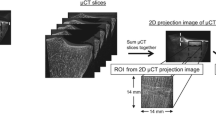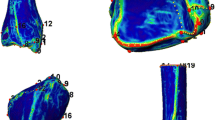Abstract:
The present study aimed to characterize bone microarchitecture assessed by computed tomography (CT) at the calcaneus in male subjects suffering from osteoporosis. Seventy-nine subjects were assessed (45 with osteoporosis and 34 control subjects matched for age). Osteoporosis was defined according to the World Health Organization classification either at the lumbar spine or at the femoral neck. Thirty-three subjects (73%) had a past history of low-energy fracture mainly represented by vertebral fractures (24/33). Nine axial sections (1 mm in width and 2 mm apart) were selected for each subject. Bone microarchitecture analysis was performed using structural (binary and skeletonized images but also skeletonization from gray levels) and fractal analyses. Bone densitometry by dual-energy X-ray absorptiometry (DXA) at the calcaneus was also performed in 73 cases. Bone mineral density (BMD) was decreased in osteoporotic patients compared with controls both at the lumbar spine and hip and also at the calcaneus (p<0.01). Also 14 microarchitectural features among 25 measured were significantly different between the two groups (p<0.01). The odds ratio for fracture per 1 control group standard deviation decrease were also significant for 13 structural features but also for BMD at the calcaneus. The odds ratios after adjustment for BMD at the calcaneus were significant for the following features (p<0.05): number of valleys, 2.8 (1.2–6.9); trabecular partition, 3.3 (1.3–7.9); apparent trabecular spacing, 1.8 (1.0–3.1); trabecular bone pattern factor, 2.2 (1.1–4.3); Euler number, 3.0 (1.1–8.7); node-to-terminus strut count, 3.3 (1.4–7.8); terminus-to-terminus strut count, 2.9 (1.2–6.9); and fractal dimension, 3.7 (1.5–9.7). Few and weak correlations were found between BMD at the calcaneus measured with DXA and features obtained from CT, suggesting that these two methods give different information about bone status. In conclusion, male osteoporosis is a disease characterized by decreased bone mass but also by microarchitectural deterioration of bone tissue which is partly independent of BMD.
Similar content being viewed by others
Author information
Authors and Affiliations
Additional information
Received: 24 April 2001 / Accepted: 6 July 2001
Rights and permissions
About this article
Cite this article
Cortet, B., Dubois, P., Boutry, N. et al. Computed Tomography Image Analysis of the Calcaneus in Male Osteoporosis. Osteoporos Int 13, 33–41 (2002). https://doi.org/10.1007/s198-002-8335-4
Issue Date:
DOI: https://doi.org/10.1007/s198-002-8335-4




